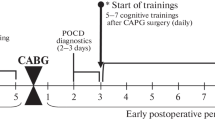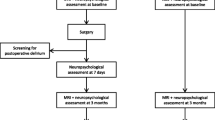Objectives. To study post-operative cognitive dysfunction (POCD)-associated parameters of high-frequency β activity in patients who have undergone coronary bypass (CB) with on-pump circulation. Materials and methods. A total of 60 patients were investigated 3–5 days before operation and on day 7–10 after CB using neuropsychological testing and recording of the resting EEG in 62 standard leads with the eyes closed. Study results were processed statistically in Statistica 10 and a data clustering method was developed; optimum solutions were sought using software implementation of a binary clipping and branching algorithm. Results. Patients with POCD were found to have greater pre- and post-operative levels of power of biopotentials in the high-frequency (20–30 Hz) β2 range as compared with patients without post-operative cognitive decline. A regression model demonstrated that the post-operative cognitive decline corresponded to high pre-operative β2 activity indicators in the right frontal areas of the cortex and lower levels in the left parietal areas after CB. Clustering of β2 power measures before and after CB showed that the best measures of cognitive status corresponded to stable assignation of patients to the clusters identifi ed. Conclusions. Specifi c correlates of POCD were identifi ed in CB patients characterized by pre-operative increases in β2 activity in the frontal areas of the right hemisphere and post-operative decreases in the left parietal areas of the cortex. The method of classifying patients in terms of levels of the pre- and post-operative β2 rhythm has good discriminating ability. Stable assignment of patients to clusters based on β2 activity was characterized by higher levels of cognitive status.
Similar content being viewed by others
References
E. Başar and A. Düzgün, “The brain as a working syncytium and memory as a continuum in a hyper timespace: Oscillations lead to a new model,” Int. J. Psychophysiol., 103, 199–214 (2016), https://doi.org/10.1016/j.ijpsycho.2015.02.019.
J. E. Pina, M. Bodner, and B. Ermentrout, “Oscillations in working memory and neural binding: A mechanism for multiple memories and their interactions,” PLoS Comput. Biol., 14, No. 11, e1006517 (2018), https://doi.org/10.1371/journal.pcbi.1006517.
M. Gola, M. Magnuski, I. Szumska, and A. Wróbel, “EEG beta band activity is related to attention and attentional defi cits in the visual performance of elderly subjects,” Int. J. Psychophysiol., 89, No. 3, 334–341 (2013), https://doi.org/10.1016/j.ijpsycho.2013.05.007.
O. M. Razumnikova and A. A. Yashanina, “Roles of rational-irrational cognitive styles in the alpha rhythm reactivity during convergent and divergent thinking,” Ros. Fiziol. Zh., O. M. 103, No. 3, 348–358 (2017).
J. Alayrangues, F. Torrecillos, A. Jahani, and N. Malfait, “Errorrelated modulations of the sensorimotor post-movement and foreperiod beta-band activities arise from distinct neural substrates and do not reflect efferent signal processing,” Neuroimage, 184, 10–24 (2019), https://doi.org/10.1016/j.neuroimage.2018.09.013.
M. Gongora, J. Bittencourt, S. Teixeira, et al., “Low-frequency rTMS over the parieto-frontal network during a sensorimotor task: The role of absolute beta power in the sensorimotor integration,” Neurosci. Lett., 611, 1–5 (2016), https://doi.org/10.1016/j.neulet.2015.11.025.
A. Todorovic, J. M. Schoffelen, F. van Ede, et al., “Temporal expectation and attention jointly modulate auditory oscillatory activity in the beta band,” PLoS One, 10, No. 3, e0120288 (2015), https://doi.org/https://doi.org/10.1371/journal.pone.012028.
G. G. Knyazev, N. V. Volf, and L. V. Belousova, “Age-related differences in electroencephalogram connectivity and network topology,” Neurobiol. Aging, 36, No. 5, 1849–1859 (2015), https://doi.org/10.1016/j.neurobiolaging.2015.02.007.
L. Wang, W. Wang, T. Yan, et al., “Beta-band functional connectivity influences audiovisual integration in older age: an EEG study,” Front. Aging Neurosci., 9, 239 (2017), https://doi.org/10.3389/fnagi.2017.00239.
A. N. Bogolepova, “Current concepts of mixed dementia,” Zh. Nevrol. Psikhiatr., 115, No. 5, 120–126 (2015), https://doi.org/10.17116/jnevro201511551120-126.
P. B. Gorelick, S. E. Counts, and D. Nyenhuis, “Vascular cognitive impairment and dementia,” Biochim. Biophys. Acta, 1862, No. 5, 860–868 (2016), https://doi.org/10.1016/j.bbadis.2015.12.015.
G. Caravaglios, E. G. Muscoso, G. Di Maria, and E. Costanzo, “Theta responses are abnormal in mild cognitive impairment: evidence from analysis of theta event-related synchronization during a temporal expectancy task,” J. Neural Transm. (Vienna), 120, No. 7, 1093–1107 (2013), https://doi.org/10.1007/s00702-012-0921-9.
R. V. Sheorajpanday, P. Mariën, G. Nagels, et al., “Subcortical vascular cognitive impairment, no dementia: EEG global power independently predicts vascular impairment and brain symmetry index reflects severity of cognitive decline,” J. Clin. Neurophysiol., 31, No. 5, 422–428 (2014), https://doi.org/10.1097/WNP.0000000000000060.
D. V. Moretti, “Theta and alpha EEG frequency interplay in subjects with mild cognitive impairment: evidence from EEG, MRI, and SPECT brain modifi cations,” Front. Aging Neurosci., 7, 31 (2015), https://doi.org/10.3389/fnagi.2015.00031.
F. Zappasodi, E. Olejarczyk, L. Marzetti, et al., “Fractal dimension of EEG activity senses neuronal impairment in acute stroke,” PLoS One, 9, No. 6, e100199 (2014), https://doi.org/10.1371/journal.pone.0100199.
W. Park, G. H. Kwon, Y. H. Kim, et al., “EEG response varies with lesion location in patients with chronic stroke,” J. Neuroeng. Rehabil., 13, 21 (2016), https://doi.org/10.1186/s12984-016-0120-2.
I. V. Tarasova, O. A. Trubnikova, O. L. Barbarash, and L. S. Barbarash, “EEG changes in patients with early and long-term postoperative cognitive dysfunction after on-pump coronary artery bypass surgery,” Nevrol. Zh., 22, No. 3, 136–141 (2017), https://doi.org/10.18821/1560-9545-2017-22-3-136-141.
S. M. Yuan and H. Lin, “Postoperative cognitive dysfunction after coronary artery bypass grafting,” Braz. J. Cardiovasc. Surg., 34, No. 1, 76–84 (2019), https://doi.org/10.21470/1678-9741-2018-0165.
E. Z. Golukhova, A. G. Polunina, N. P. Lefterova, et al., “Electroencephalography as a tool for the diagnosis of ischemic changes in the brain after coronary artery bypass grafting,” Kreativ. Kardiol., No. 1, 107–122 (2012).
O. A. Trubnikova, E. S. Kagan, T. V. Kupriyanova, et al., Neuropsychological status of patients with stable ischemic heart disease and factors affecting it,” Kompleks. Probl. Serdech. Sosud. Zabol., 6, No. 1, 112–121 (2017).
Y. Mezentsev and I. Estraykh, “On problems and algorithm of clustering and constructing optimal routes by speed criterion,” in: Proc. 14th Int. Sci. Techn. Conf. on Actual Problems of Electronic Instrument Engineering, APEIE (2018).
J. Strunk, T. James, J. Arndt, and A. Duarte, “Age-related changes in neural oscillations supporting context memory retrieval,” Cortex, 91, 40–55 (2017), https://doi.org/10.1016/j.cortex.2017.01.020.
S. Aurtenetxe, N. P. Castellanos, S. Moratti, et al., “Dysfunctional and compensatory duality in mild cognitive impairment during a continuous recognition memory task,” Int. J. Psychophysiol., 87, No. 1, 95–102 (2013), https://doi.org/10.1016/j.ijpsycho.2012.11.008.
S. Haegens, J. Vergara, R. Rossi-Pool, et al., “Beta oscillations reflect supramodal information during perceptual judgment,” Proc. Natl. Acad. Sci. USA, 114, No. 52, 13810–13815 (2017), https://doi.org/10.1073/pnas.1714633115.
A. L. Proskovec, A. I. Wiesman, E. Heinrichs-Graham, and T. W. Wilson, “Beta oscillatory dynamics in the prefrontal and superior temporal cortices predict spatial working memory performance,” Sci. Rep., 8, No. 1, 8488 (2018), https://doi.org/10.1038/s41598-018-26863-x.
B. Bramson, O. Jensen, I. Toni, and K. Roelofs, “Cortical oscillatory mechanisms supporting the control of human social-emotional actions,” J. Neurosci., 38, No. 25, 5739–5749 (2018), https://doi.org/10.1523/JNEUROSCI.3382-17.2018.
Author information
Authors and Affiliations
Corresponding author
Additional information
Translated from Zhurnal Nevrologii i Psikhiatrii imeni S. S. Korsakova, Vol. 121, No. 2, Iss. 1, pp. 18–23, February, 2021.
Rights and permissions
About this article
Cite this article
Tarasova, I.V., Razumnikova, O.A., Trubnikova, O.A. et al. Neurophysiological Correlates of Post-Operative Cognitive Disorders. Neurosci Behav Physi 51, 1234–1238 (2021). https://doi.org/10.1007/s11055-021-01185-0
Received:
Accepted:
Published:
Issue Date:
DOI: https://doi.org/10.1007/s11055-021-01185-0




